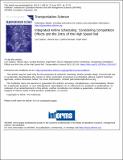| dc.contributor.author | Cadarso, Luis | |
| dc.contributor.author | Vaze, Vikrant | |
| dc.contributor.author | Marin, Angel | |
| dc.contributor.author | Barnhart, Cynthia | |
| dc.date.accessioned | 2017-06-22T14:37:10Z | |
| dc.date.available | 2017-06-22T14:37:10Z | |
| dc.date.issued | 2016-01 | |
| dc.date.submitted | 2015-10 | |
| dc.identifier.issn | 0041-1655 | |
| dc.identifier.issn | 1526-5447 | |
| dc.identifier.uri | http://hdl.handle.net/1721.1/110163 | |
| dc.description.abstract | Airlines and high speed rail are increasingly competing for passengers, especially in Europe and Asia. Competition between them affects the number of captured passengers and, therefore, revenues. We consider competition between airlines (legacy and low-cost) and high speed rail. We develop a new approach that generates airline schedules using an integrated mixed integer, nonlinear optimization model that captures the impacts of airlines’ decisions on passenger demand. We estimate the demand associated with a given schedule using a nested logit model. We report our computational results on realistic problem instances of the Spanish airline IBERIA and show that the actual airline schedules are found to be reasonably close to the schedules generated by our approach. Next, we use this optimization modeling approach under multimodal competition to evaluate multiple scenarios involving entry of high speed rail into new markets. We account for the possibility of demand stimulation as a result of the new services. We validate our approach using data from markets that had an entry by high speed rail in the past. The out-of-sample validation results show a close match between the predicted and observed solutions. Finally, we use our validated model to predict the impacts of future entry by high speed rail in new markets. Our results provide several interesting and useful insights into the schedule changes, fleet composition changes, and fare changes that will help the airline cope effectively with the entry of high speed rail. | en_US |
| dc.language.iso | en_US | |
| dc.publisher | Institute for Operations Research and the Management Sciences (INFORMS) | en_US |
| dc.relation.isversionof | http://dx.doi.org/10.1287/trsc.2015.0617 | en_US |
| dc.rights | Creative Commons Attribution-NonCommercial-NoDerivs License | en_US |
| dc.rights.uri | http://creativecommons.org/licenses/by-nc-nd/4.0/ | en_US |
| dc.source | Informs | en_US |
| dc.title | Integrated Airline Scheduling: Considering Competition Effects and the Entry of the High Speed Rail | en_US |
| dc.type | Article | en_US |
| dc.identifier.citation | Cadarso, Luis; Vaze, Vikrant; Barnhart, Cynthia and Marín, Ángel. “Integrated Airline Scheduling: Considering Competition Effects and the Entry of the High Speed Rail.” Transportation Science 51, no. 1 (February 2017): 132–154 © 2016 The Author(s) | en_US |
| dc.contributor.department | Massachusetts Institute of Technology. Department of Civil and Environmental Engineering | en_US |
| dc.contributor.mitauthor | Barnhart, Cynthia | |
| dc.relation.journal | Transportation Science | en_US |
| dc.eprint.version | Final published version | en_US |
| dc.type.uri | http://purl.org/eprint/type/JournalArticle | en_US |
| eprint.status | http://purl.org/eprint/status/PeerReviewed | en_US |
| dspace.orderedauthors | Cadarso, Luis; Vaze, Vikrant; Barnhart, Cynthia; Marín, Ángel | en_US |
| dspace.embargo.terms | N | en_US |
| dc.identifier.orcid | https://orcid.org/0000-0003-2431-2706 | |
| mit.license | PUBLISHER_CC | en_US |
